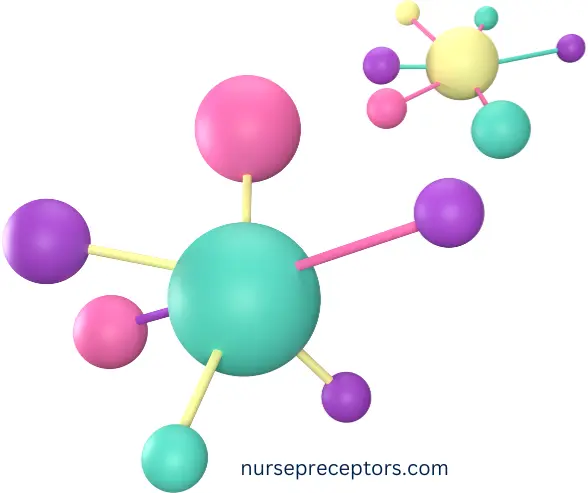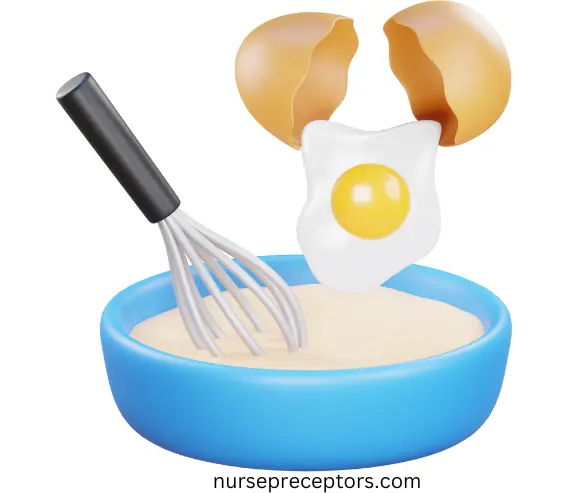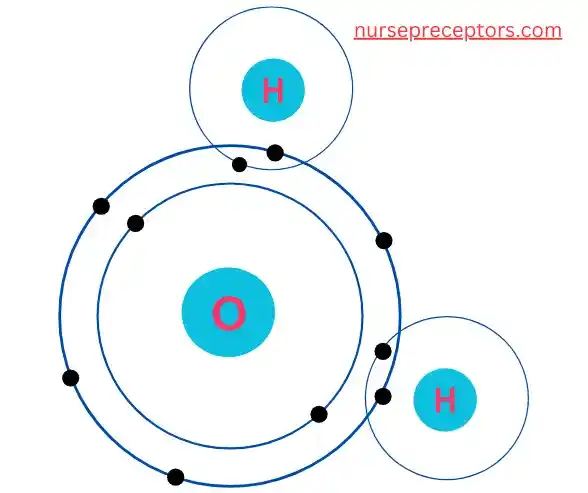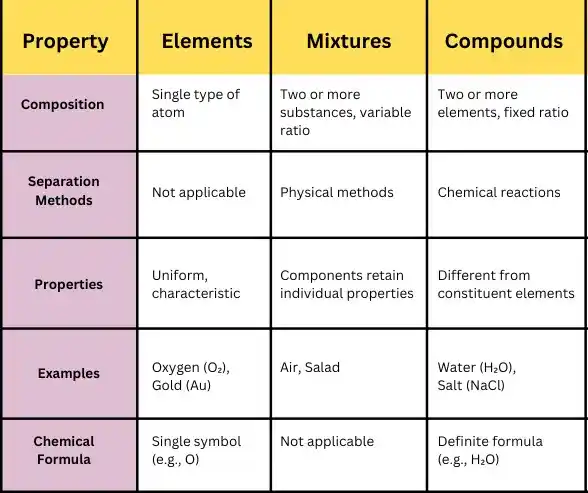The field of chemistry seeks to comprehend the properties and interactions of matter. All substances in our surroundings can be categorized as elements-mixtures-compounds.
These categories form the cornerstone of chemical science, influencing everything from the properties of substances to how they interact with each other. This comprehensive guide will explore the characteristics, differences, and significance of elements-mixtures-compounds. Learn full guide from Nurse Preceptors.
What are Elements?
Elements are fundamental substances that consist of only one type of atom and cannot be broken down into simpler substances by chemical means. Each element is defined by the number of protons in its nucleus, known as the atomic number.
The hydrogen atom, which is the fundamental constituent of all matter, consists of a single proton. Uranium, the heaviest naturally occurring element, consists of 92 protons, which distinguishes it from other elements in the periodic table.

Properties of Elements
- Simplicity: The fundamental components of matter are known as elements. They consist of pure substances that cannot undergo chemical breakdown into simpler forms.
- Uniform Composition: The composition of each element remains uniform and exhibits distinct physical and chemical properties. For example, a sample of pure copper will demonstrate uniform electrical conductivity and malleability.
- States of Matter: Elements can exist in different states depending on temperature and pressure. While many elements are solid at room temperature (like iron), others are gases (like oxygen) or liquids (like mercury).
- Stability and Reactivity: Elements vary in their chemical stability. Noble gases like helium and neon are very stable and inert, while alkali metals like sodium are highly reactive.
Incorporating Revised Bloom’s Taxonomy in NCLEX-RN Exam Preparation
Examples of Elements
- Metals: Metals, such as gold (Au), silver (Ag), and aluminum (Al), are good conductors of heat and electricity. They are typically malleable and ductile, making them useful in various applications, from construction to electronics.
- Non-metals: Non-metals, such as oxygen (O), carbon (C), and nitrogen (N), are generally poor conductors of heat and electricity. They often exist in gaseous or brittle solid forms and are crucial for biological systems and chemical processes.
- Metalloids: Metalloids, such as silicon (Si) and germanium (Ge), possess characteristics that exhibit an intermediary nature between those of metals and non-metals. They are semiconductors, essential for the electronics industry.
The Periodic Table
The periodic table systematically arranges all identified elements in increasing order of their atomic numbers. This organization reveals patterns in element properties, such as trends in electronegativity, atomic radius, and ionization energy.
Elements located within the same group (column) typically display similar chemical properties because they possess an identical number of valence electrons. For instance, elements in Group 1 (alkali metals) are highly reactive, especially with water.
What are Mixtures?
Mixtures are combinations of two or more substances that retain their individual chemical properties and are not chemically bonded. The components of a mixture can be present in any proportion, and they can be separated by physical means without undergoing a chemical reaction.

Types of Mixtures
1. Homogeneous Mixtures (Solutions):
These mixtures have a uniform composition throughout, and the individual components are not distinguishable. Examples include:
- Saltwater: Where salt is completely dissolved in water, forming a single-phase solution.
- Air: A mixture of gases including nitrogen, oxygen, and trace amounts of other gases, uniformly mixed.
- Alloys: Metals like brass (copper and zinc) are mixed to create materials with improved properties for specific uses.
What are the most common ethical issues encountered by nurses in clinical practice today?
2. Heterogeneous Mixtures:
These mixtures have a non-uniform composition, with distinct phases or parts. Examples include:
- Salad: Different ingredients like lettuce, tomatoes, and cucumbers are easily identifiable and not uniformly distributed.
- Sand and Water: The sand particles do not dissolve and remain separate from the water.
- Granite: A rock composed of minerals like quartz, feldspar, and mica, that are visible to the naked eye.
Separation Techniques of Mixture
Mixtures can be separated into their components using various physical methods based on differences in physical properties:
- Filtration: Solid particles can be separated from liquids using filtration. For instance, sand can be separated from water by passing the mixture through a filter.
- Distillation: Separates substances based on their boiling points. It is commonly used to purify liquids, such as separating ethanol from a water-ethanol mixture.
- Magnetic Separation: Utilizes magnets to attract magnetic materials, such as separating iron filings from a mixture of iron and sulfur.
- Centrifugation: Separates components based on density by spinning a mixture at high speed, commonly used to separate blood components or cream from milk.
- Evaporation: Removes a liquid from a solution to leave a solid residue, as in obtaining salt from seawater.
What are Compounds?
Compounds are substances that result from the chemical bonding of two or more elements in specific proportions. These bonds involve the sharing or transfer of electrons between atoms, resulting in a substance with properties different from the individual elements that constitute it.

Characteristics of Compounds
- Fixed Composition: Compounds have a definite chemical formula, indicating the exact ratio of elements. For example, carbon dioxide (CO₂) always consists of one carbon atom bonded to two oxygen atoms.
- Unique Properties: The properties of a compound are distinct from those of its constituent elements. For example, water (H₂O) is a liquid at room temperature, unlike hydrogen and oxygen, which are both gases.
- Chemical Bonds: Compounds are held together by either ionic or covalent bonds:
- Ionic Bonds: Through the exchange of electrons between atoms, an ionic bond is formed, resulting in the attraction between oppositely charged ions. Sodium chloride (NaCl) is a classic example.
- Covalent Bonds: Formed when atoms share electrons, resulting in a stable balance of attractive and repulsive forces. Water (H₂O) and carbon dioxide (CO₂) are common examples of covalent compounds.
Examples of Compounds
Water (H₂O): Composed of hydrogen and oxygen, water is essential for all known forms of life.
Carbon Dioxide (CO₂): Formed from carbon and oxygen, it is a vital component of the carbon cycle and is used by plants in photosynthesis.
Sodium Chloride (NaCl): Known as table salt, it is formed from sodium and chlorine and is crucial for human health and various industrial processes.
Exploring Gordon’s 11 Functional Health Patterns
Types of Compounds
- Ionic Compounds: Ionic compounds form when metals and non-metals combine, resulting in the formation of positively and negatively charged ions. These compounds possess high melting and boiling points and can conduct electricity when in a molten state or dissolved in water. Example: Magnesium oxide (MgO).
- Covalent Compounds: Formed between non-metals, these compounds share electron pairs and generally have lower melting and boiling points compared to ionic compounds. They do not conduct electricity. Example: Methane (CH₄).
- Metallic Compounds: These compounds consist of metal atoms bonded by a “sea” of shared free electrons, which allow metals to conduct electricity and heat efficiently. An example of an alloy composed of iron and carbon is steel.
Comparing Elements-Mixtures-Compounds
To understand the differences between elements-mixtures-compounds, it’s helpful to make the following comparisons:

Expanded Comparisons
1. Nature of Bonding and Interactions
Elements: No chemical bonds between atoms of the same type (except in diatomic elements like O₂).
Mixtures: No chemical bonds between different components; they are merely mixed.
Compounds: Atoms are chemically bonded, either through ionic or covalent bonds, forming a new substance.
Comparing and contrasting ancient healthcare practices in ancient cultures
2. Homogeneity and Heterogeneity
Elements: Always homogeneous.
Mixtures: Can be homogeneous or heterogeneous, depending on the distribution of components.
Compounds: Always homogeneous, with a uniform composition throughout.
3. Behavior Under Chemical Reactions
Elements: This substance can undergo chemical reactions and form new compounds.
Mixtures: Components can react independently, but the mixture itself does not undergo a collective chemical change.
Compounds: Chemical reactions can break down substances into their basic elements.
4. Physical and Chemical Properties
Elements: Exhibit properties that are specific and distinctive to the element.
Mixtures: Properties are a combination of the properties of the individual components.
Compounds: Exhibit new properties distinct from those of the constituent elements.
Florence Nightingale’s work in literature and the Women’s Movement
Summary
Understanding the basic nature and differences between elements-mixtures-compounds is foundational for exploring chemistry and the natural world.
Elements are pure substances made of a single type of atom and cannot be decomposed into simpler substances. They serve as the basic building blocks of matter.
Mixtures are combinations of two or more substances that maintain their individual properties and can be separated by physical means. They are versatile and exist in many forms, from solutions to heterogeneous mixtures.
Compounds are chemical amalgamations of two or more elements in fixed ratios, with unique properties that differ from those of their elements. They play a fundamental role in chemical reactions and the creation of new substances.
These categories not only help us classify and understand the materials around us but also provide insight into the intricate processes that govern the natural and synthetic worlds. Whether you’re studying the molecular structure of a new compound or simply mixing ingredients in your kitchen, the principles of elements-mixtures-compounds are at play, revealing the complexity and beauty of chemistry.
References:
- Introduction of Elements, Compounds, and Mixtures. (n.d.). Unacademy. https://unacademy.com/content/nda/study-material/chemistry/introduction-of-elements-compounds-and-mixtures/
- Define Element compounds and mixtures with Examples. Chemistry Q&A. (n.d.). Byjus.com. Retrieved July 17, 2024, from https://byjus.com/question-answer/define-element-compound-and-mixture-with-examples/
- Physical and Chemical Properties of Elements – HSC Chemistry. (n.d.). Science Ready. https://scienceready.com.au/pages/properties-of-elements
- What is the definition of “compound”, “mixture”, “element” and “molecule”? (n.d.). Chemistry Stack Exchange. https://chemistry.stackexchange.com/questions/2879/what-is-the-definition-of-of-compound-mixture-element-and-molecule